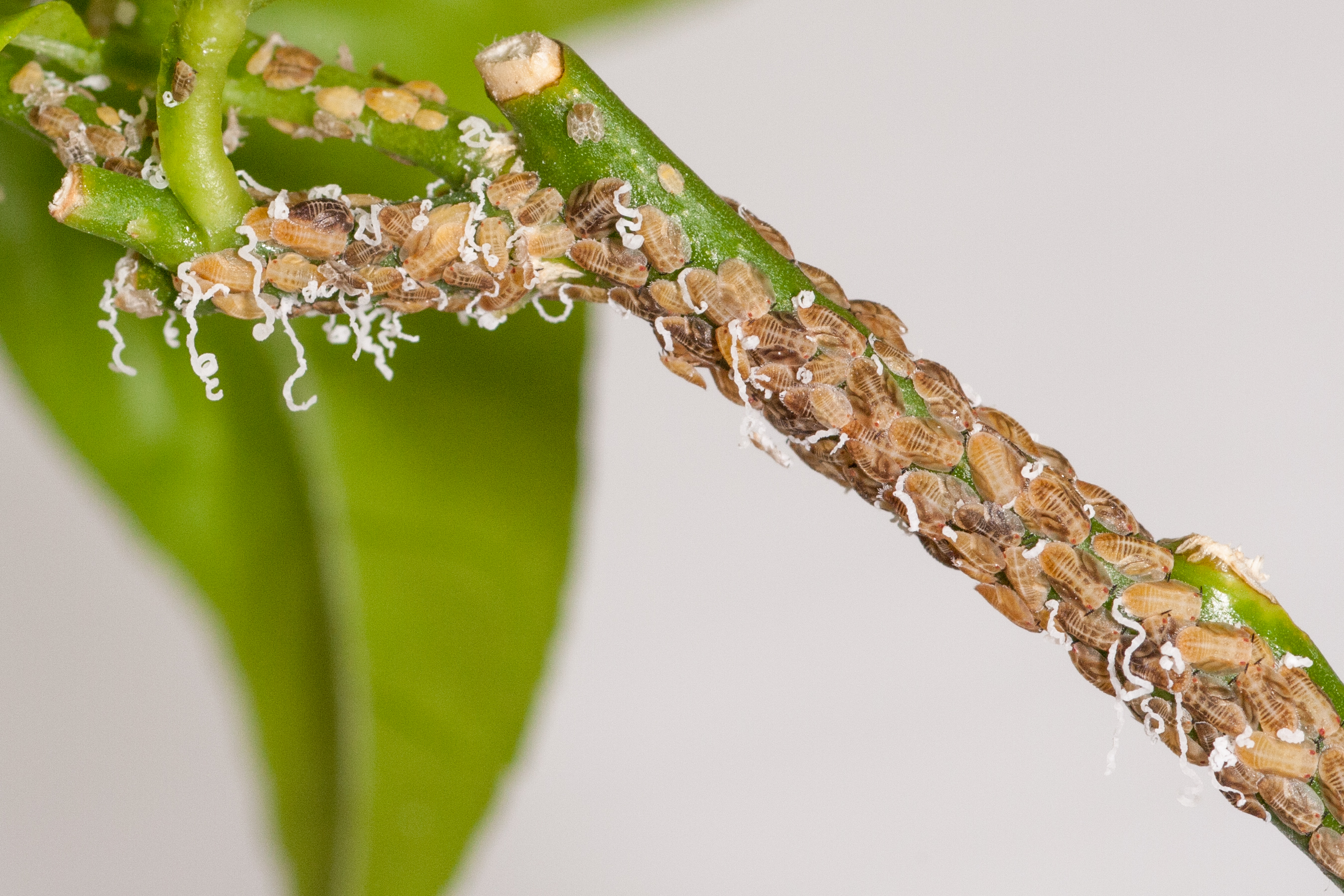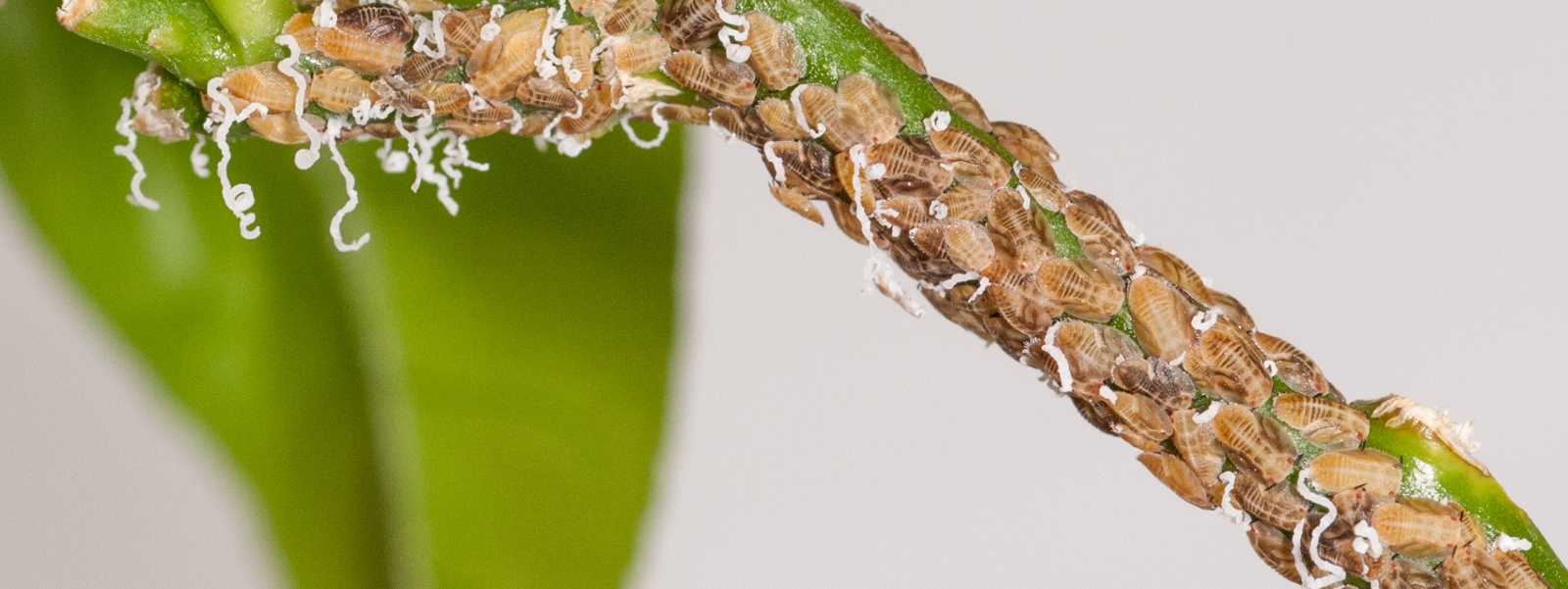Organic growers have few tools to fight citrus psyllid

Asian citrus psyllid – Photo/Mike Lewis/University of California, Riverside

By Ching Lee
As an organic citrus grower and packer in Ventura County, John Wise has long recognized the threat of the Asian citrus psyllid to his business and livelihood.
The threat has become greater now that part of his region is under quarantine as state agricultural officials continue to find more residential citrus trees infected with huanglongbing, a fatal bacterial disease that the insect can transmit.
“It’s like 3 miles from us where the quarantine is,” said Wise, owner of Sespe Creek Organics in Fillmore. He noted other growers from whom he receives fruit are across the street from the quarantine area, which covers a 5-mile radius from where the initial diseased trees were found.
The Asian citrus psyllid is not a new menace for California citrus growers. Since the state’s first confirmed finding of the bug in 2008, intensive efforts have been made to detect and control the invasive pest—and to eradicate huanglongbing, also known as citrus greening disease. This includes seasonal areawide spraying programs using broad spectrum insecticides to keep psyllid numbers down.
For organic citrus growers, there remain few effective treatment options approved for organic production to control the psyllid. The two most widely used products—Entrust, which contains spinosad, and Pyganic, which contains pyrethrin—have relatively short staying power.
After application, the residual life of the organic insecticides is mere days compared to conventional insecticides, which can last weeks to months. That means organic growers must reapply more frequently—and spend more money.
Because of their short residual effect, organic insecticides are not approved for use in a quarantine. Products recommended by the University of California are all conventional because they have the longest lasting residuals and are the most effective, said Keith Okasaki, regulatory manager for the California Department of Food and Agriculture Citrus Pest and Disease Prevention Division.
“When it comes to spraying to move fruit prior to harvest, the goal is really to not have any psyllids on the load,” Okasaki said.
Studies done on organic insecticides show they may be effective at killing psyllids for two or three days after harvest, Okasaki said. Therefore, using the products “present a higher risk of moving psyllids” that may be on the harvested crop because the insecticides may not kill all the insects, he added.
To move fruit out of the quarantine area, organic growers have only two options: to field clean the harvested crop by mechanically removing all the leaf and plant litter or to wet wash the crop.
Wise said he’s still trying to figure out how to meet the quarantine requirements. So far, he has only lemons coming from the quarantine area, and the main season usually runs from February through August or September.
Regardless of the quarantine, Wise said he continues to use organic insecticides in the orchard, following what’s recommended. Because of the cost, he said he’s gotten away from regular-scheduled sprays and uses the products only when he sees higher bug numbers. But other organic growers are not spraying as much anymore, if at all, he said, mainly because it’s so expensive.
“The lemon market hasn’t been very good in the last few years, and the orange market has been bad for a while,” Wise said. “It’s not like the government’s going to give you money to spray.”
Because he’s organic, Wise said it would be most ideal if beneficial insects could do all the work, so growers wouldn’t need to spray. The state continues to release Tamarixia radiata wasps to control psyllid populations, and studies show the parasitic insects can knock down psyllid numbers by 20% to 88%, depending on location and time of year.
“Biocontrol never takes its prey down completely, and it doesn’t take very many infected (Asian citrus psyllids) to infect a tree and begin its decline,” said Ben Faber, University of California Cooperative Extension farm advisor for Ventura and Santa Barbara counties. For this reason, Wise said he’s not confident biological controls such as the wasp should be “the only thing we should be doing.”
Mark Hoddle, UC Riverside biological control specialist, said there may be times when insecticides are necessary, “but I don’t think you need to be spraying with the intensity and frequency that’s currently going on,” especially when there are “some pretty potent natural enemies that exist naturally in citrus orchards.”
Beneficial insects would be even more effective at fighting psyllids if growers can control ant populations, particularly Argentine ants, which are a big problem in Southern California, Hoddle said. That’s because the ants protect the psyllids, which produce “candy poop,” a sweet, sticky waste product that the ants consume.
In work he’s done in orange and grapefruit orchards in Riverside County, Hoddle said he was able to suppress more than 95% of the ants using sugar-water baits containing the spinosad insecticide. He noted the orchards otherwise used minimal or no insecticides. Once ant numbers plummet, the psyllid’s natural enemies surge, providing “massive amounts of free pest control,” he said.
The frequent use of insecticides not only costs more money, he said, but insects could develop resistance to the products, making them ineffective. Hoddle suggested a reevaluation of the state’s current policy on insecticide use, which he noted was established back when California was expecting to undergo a catastrophe like what’s been observed in Florida, where citrus production has dropped 90% since greening disease first showed up in 2005.
In California, citrus greening—first detected in 2012 in Los Angeles County residential citrus trees—to date has not been found in any commercial orchards. About 6,000 of the state’s citrus trees have died or been destroyed because of huanglongbing. That’s a tiny fraction of all the citrus trees growing in Southern California, Hoddle said.
Though some people credit the state’s robust detection and eradication program for keeping the disease at bay, Hoddle said he believes biocontrol programs have had a lot to do with it as well. He pointed to the state’s reduced psyllid numbers—down at least 70%—especially in areas where trees were once “dripping with psyllids.” He said the declines started after the release of the parasitic wasps.
The state remains firm about actively eradicating huanglongbing by removing all infected trees and by treating every property within 250 meters of the infection site with a conventional insecticide. The actions are mandated by law because there remains no cure for greening disease that’s been verified by the U.S. Department of Agriculture, said Victoria Hornbaker, CDFA director of the Citrus Pest and Disease Prevention Division.
Until there is a proven cure, Hornbaker said, “we absolutely have to stay on top of the Asian citrus psyllid population.”
“From everything that we’ve seen from elsewhere in the United States and in the world,” she said, “if you keep your populations as low as possible, you reduce the spread of the bacteria” that causes huanglongbing.
(Ching Lee is an assistant editor of Ag Alert. She may be contacted at clee@cfbf.com.)




